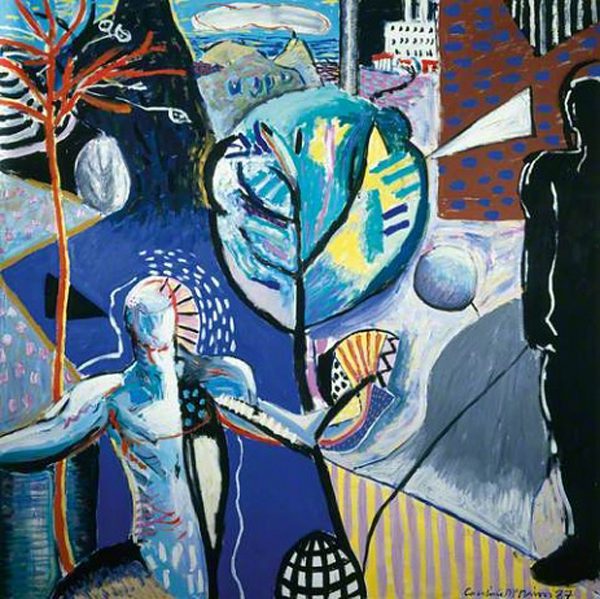In 1989, the Scottish artist Caroline McNairn (1955-2010) spent a year in Russia and Ukraine. Producing some of her most noted works and exchanging ideas with artists from the about-to-be former Soviet Union, the visit was one of the major influences on McNairn’s artistic output until her tragically early death in 2010. Dreaming of Heroic Days, currently on display at Summerhall as part of the Edinburgh Art Festival, is a magnificent and rare opportunity to see a substantial exhibition of McNairn’s paintings, some of which were produced in Russia and Ukraine and all of which bear the influence of her experiences there.
Gaining notability as the last cold war was waning, McNairn’s work was part of a special moment in Scottish painting, largely spearheaded by the 369 Gallery, an innovative Edinburgh institution that promoted young Scottish artists in the 1980s and 1990s and also engendered international cultural exchanges. Having exhibited at New York’s Avenue B Gallery in 1986, McNairn received praise from both Jean-Michel Basquiat and Keith Haring, artists whose work shares with McNairn an investment in the drama of heroic gestures and the urgent, illicit poetry of graffiti scrawl.
Dramatically combining elements of abstraction, figuration, textuality and landscape (or more precisely cityscape), McNairn’s canvases are exquisite fusions. Her art is radical because it is energized and enervated by the combination of disparate elements. The American artist Jack Tworkov (1900-1982) once wrote of his own practice that he felt “a certain inclination toward the monstrous… it is common to think of expression in relation to art and we miss how much is really suppression”. In her looming figures and shadows, peculiar spiral-patterned bulges and skinny leafless trees, much of McNairn’s work also seems to occupy the tightrope above “suppression” and “expression”, a tightrope that also animates another unstable dichotomy in her work between the “monstrous” and the “beautiful”. In On the Edge (2000), for example, a figure seems to split or morph into two while on the other side of the painting, figures are in mourning and a hammer and a poppy form an unexpected bouquet.
For an artist who grew up in the Scottish borders, it is perhaps expected that the metaphor of borders is an important one within McNairn’s work, a fact the poet Jane Goldman uses as a reference point in an accompanying publication to the exhibition entitled Border Thoughts (2014). This preoccupation is nowhere more evident than in the painting Looking Outside (1987), from the collection of the National Galleries of Scotland. Occupying the border of domestic interior and outside space, McNairn also extends the poetics of her painting to explore the border between the internal space of the mind and the external space of the environment, a border that seems fragile and porous in McNairn’s work. The piece conflates domestic details such as houseplants and posters with urban aspects such as walls, towers, bridges, trees and rivers. These symbols are constantly ambiguous, unhinged from a definitive tie to representation and instead able to convey multiple symbols at once: a chair-arm could be a pathway, a rug might be a river, a shadow of a figure could well be a traffic light post. The space McNairn allows for poetic interpretation in her work is one of its most striking characteristics.
Reintroducing one of Scotland’s most ambitious and demanding painters, Dreaming of Heroic Days is a wonderfully timely exhibition for many reasons, not least the opportunity to see the beauty, sympathy, poetry and common understanding that McNairn found and developed with the artists of Ukraine and Russia at a time when relations between Russia and the West were emerging from the chilled hostilities into which we appear to be heading once again.
Caroline McNairn: Dreaming of Heroic Days, Summerhall, Edinburgh until 26 September as part of Edinburgh Art Festival.
Colin Herd
Credits
1. Caroline McNairn, In the Making, Courtesy of City Art Centre, Edinburgh.
Follow us on Twitter @AestheticaMag for the latest news in contemporary art and culture.




